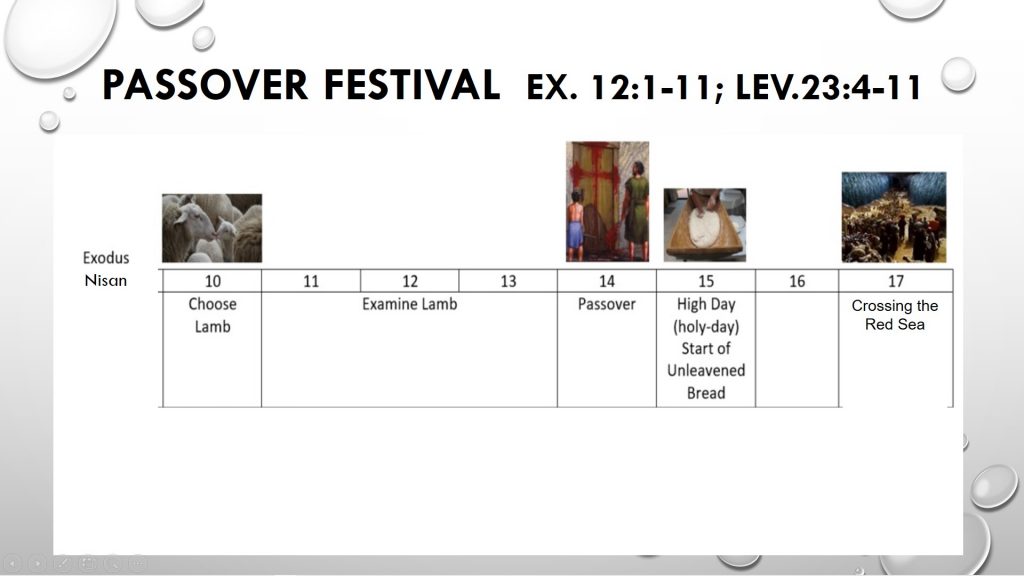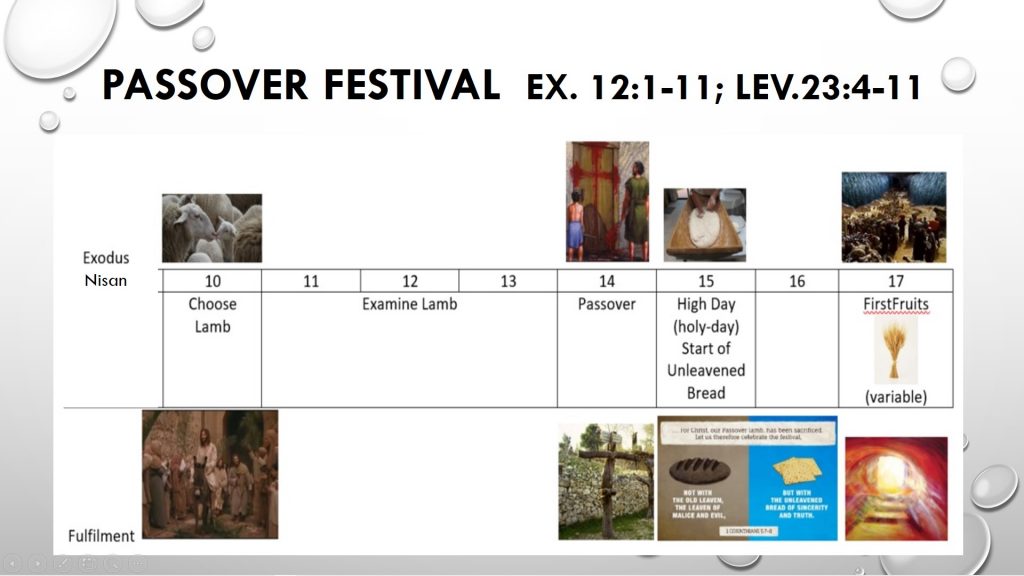The Moedim – Pesach (Passover)
The Moedim – Pesach
The Passover Festival (Moed) is decribed in Lev.23:4-11. In NT times and later, Passover covers the first three festivals, or sometimes referred to as ‘The Feast’, meaning Unleavened Bread, which also covers the three festivals.
Origin of the word Passover – literally to skip over or spare Ex. 12:11, to hover over to prevent the Angel of Death from entering the house. Ex. 12:23b
The sequence of events at the first Passover in Ex. 12-14

Fulfilled in Jesus’ death and resurrection:

For a discussion of the actual days of Jesus’ crucifixion and resurrection on which this chart was based, please refer to the book “Three Days and Three Nights – which changed the world” (Go to https://davidsbiblenotes.co.uk/downloads)
Summary of discussion
Moedim Session: Passover Festival and Its Significance
David led a session on the Moedim, focusing on the Passover festival and its significance during New Testament times. He emphasized the connection of the Passover to the first three spring festivals described in Leviticus 23, with the Passover being the first. David detailed the sequence of events, starting with the Passover on the 14th day of the first month, followed by the feast of unleavened bread, including a seven-day period of eating bread without leaven, and the mandatory offerings in the Tavernacle/Temple. He also explained that these feasts were tied to the agricultural cycle, reflecting the harvest season, and looked at the shift in the calendar by six months in Ex. 12:2, which brought the date of the ark’s landing from the seventh month to the first month (on the 17th day) Gen. 8:4
Passover Story and Symbolism Explained
David shared a detailed explanation of the original Passover story, highlighting its significance and symbolism. He explained that Passover commemorates the Israelites’ liberation from slavery in ancient Egypt and the destruction of the firstborn of the Egyptians. David emphasized the role of the sacrificial lamb in this story, noting its blood was used to mark the Israelites’ homes and spare them from destruction. He also compared the mother bird’s protective nature towards her chicks to God’s role in the Passover. Additionally, David discussed the timing of the Passover sacrifice, its aftermath, and the customs that have continued throughout the centuries.
Jewish Festivals, Passover, and Easter Interpretation
David discussed the significance of various Jewish festivals, particularly focusing on the Passover and Unleavened Bread. He suggested that the Red Sea crossing might have occurred on the 17th of Nissan, three days after the day of Passover. David also presented his interpretation of the events surrounding Jesus’ crucifixion and resurrection, aligning them with the Jewish festivals and the Christian celebration of Easter. He highlighted that Jesus passed every test by Jewish leadership and fulfilled the Passover festival as the chosen lamb. Lastly, David delved into the history of Passover observance, explaining its transition from being observed in tents or homes to a central location like Shiloh where the tabernacle was situated.
Passover Symbolism and Christ’s Connection
The team discussed the symbolism and significance of Passover, with a focus on the sacrificial offering of the lamb and its connection to Christ’s sacrifice. The discussion concluded with a reflection on the importance of celebrating Passover as a deliverance from sin and an opportunity to reflect on God’s glory.
Discussing the Symbolism of the Passover Lamb
John, David, and others discussed the symbolic meaning of the year-old lamb in the biblical Passover story. They examined the lamb as a powerful animal requiring careful handling, representing Jesus as a sacrificial lamb in His prime. The discussion centred on how households would care for and protect the unblemished lamb, possibly involving extended families coming together. The lamb’s sacrifice is seen as sufficient to cover all households.
Exploring Old Testament Offerings and Festivals
Ray and David delved into the intricacies of various offerings and festivals mentioned in the Old Testament, primarily focusing on the unleavened bread and the Passover. They discussed the details of the offerings, the concept of the first fruits, and the timing of the Passover sacrifice in relation to the crucifixion of Jesus. David also clarified the changes made to the festival of 1st Fruits to distinguish it from the Christian celebration of resurrection. Lastly, he suggested that the first four feasts described in Lev. 23:1-21 have already been fulfilled on the actual days of the same months in Jesus’ death and resurrection and the coming of the Holy Spirit at Pentecost, implying that the remaining three, including the Feast of Trumpets, Day of Atonement, and Feast of Tabernacles, could also be fulfilled precisely.
Discussing Passover’s Spiritual Significance
David, T&A, and others discussed the significance of the Passover feast, emphasizing its spiritual meaning beyond its historical and cultural contexts. They highlighted that Passover is not only a Jewish celebration but also a festival for all believers who recognize its symbolism of freedom, redemption, and deliverance. They also lamented that some Christian churches do not fully understand or appreciate the Passover feast, thus missing out on its rich spiritual implications. The group encouraged personal appropriation of the Passover’s message and its relevance to their daily lives.
Exploring Jewish Festival Periods and Their Significance
The team discussed the significance of the 7-day period observed in the Jewish festival system, with a focus on the Passover and Sukkot celebrations. They explored the historical and spiritual context behind these periods, highlighting their connection to the sacrifice of Jesus and the new beginnings they represent. The team also emphasized the importance of respecting the cultural origins of these festivals while incorporating their own insights and beliefs. The conversation included various anecdotes and references, adding to the richness and depth of the discussion.
Discussing Abraham and Israelites’ Salvation Story
The team discussed the story of Abraham and the Israelites in the books of Genesis to Joshua, focusing on its relevance to Christian salvation. They emphasized that the deliverance of the Israelites from Egypt represents the moment of salvation, with their subsequent journey through the wilderness depicting the process of maturity in the faith. The team also highlighted that Jesus came to redeem the whole world and that salvation is a spiritual process, not defined by ethnicity or physical descent. They examined the significance of spiritual rebirth in Jewish and Christian traditions, drawing from various passages. The group also reflected on God’s unchanging election of Israel despite their unfaithfulness, seeing parallels to God’s mercy toward believers in the present age.